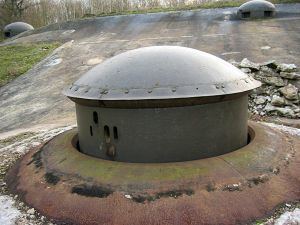Open tothe public Yes Built by CORF | Condition Preserved | |
 | ||
Materials Concrete, steel, deep excavation Similar | ||
Ouvrage Bois- Karre is located in the Fortified Sector of Thionville of the Maginot Line, facing the France - Luxembourg border. The petit ouvrage is situated in the Cattenom Forest between the gros ouvrages Soetrich and Kobenbusch, just south of Boust. It is unusual for a Maginot fortification in its construction as a single blockhouse, with no underground gallery system or remotely located entries. Bois-Karre has been preserved and is maintained as a museum.
Contents
Design and construction
Bois-Karre was surveyed by CORF (Commission d'Organisation des Régions Fortifiées), the Maginot Line's design and construction agency, in 1930. Work by the contractor Degaine-Dubois began in 1931, and the position became operational in 1935, at a cost of 10 million francs.
Bois-Karre was planned as an anchor point for a fortified line of retreat from the Cattenom salient formed by Kobenbusch and Oberheid. A firing chamber is arranged to cover the reinforcing line (bretelle de Cattenom), which was to be anchored at its other end by Block 2 of Ouvrage Galgenberg. The reinforcing line was never built.
Description
The single two-level combat block comprises two firing chambers and one machine gun turret. The west firing chamber was armed with a machine gun embrasure and a machine gun/47mm anti-tank gun embrasure (JM/AC47). The east firing chamber was equipped with two JM/AC47 embrasures and a JM embrasure. Three automatic rifle cloches (GFM) on the surface provided spotting for ouvrage Métrich, along with a machine gun turret. The integral usine was equipped with two 40 horsepower (30 kW) Renault engines.
Several casemates, observatories and infantry shelters are located around Bois-Karre, including
None of these are connected to the ouvrage or to each other. All were built by CORF. The Casernement de Cattenom provided peacetime above-ground barracks and support services to Bois-Karre and other ouvrages in the area.
Manning
The garrison comprised 91 men and two officers of the 168th Fortress Infantry Regiment under Sub-Lieutenant Boulay.
History
See Fortified Sector of Thionville for a broader discussion of the events of 1940 in the Thionville sector of the Maginot Line.Current condition
The ouvrage which retains a large portion of its equipment, has been restored and may be visited.
